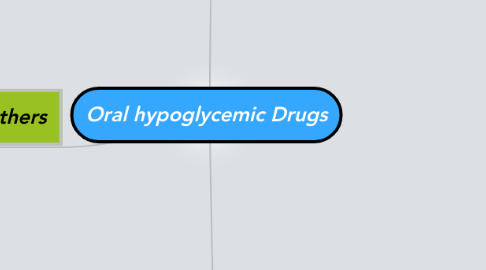
1. others
1.1. a-Glucosidase inhibitors
1.1.1. Acarbose
1.1.2. MOA:
1.1.2.1. Decrease carbohydrate digestion & glucose absorption in small intestine as it reversibly inhibit a-glucosidase enzyme.
1.1.3. features:
1.1.3.1. It decreases post-prandial hyper-glycemia
1.1.3.2. it's taken just before meals
1.1.3.3. No risk of hypoglycemianif used alone
1.1.4. Uses:
1.1.4.1. Effective alone in earliest stages of impaired glucose tolerance.
1.1.4.2. combined with sulfonylurea in type II
1.1.4.3. can be used in Type I
1.1.5. side effects:
1.1.5.1. Flatulence, Diarrhea & abdominal pain
1.1.5.1.1. bcoz it's metabolized by intestinal bacteria.
1.2. Di-peptidyl peptidase-4 inhibitors
1.2.1. Sitagliptin
1.2.2. MOA:
1.2.2.1. inhibit DPP-4 enzyme (this enzyme degrade natural incretins hormones) => increase level of incretin => stimulate the insulin secretion more.
1.2.3. Uses:
1.2.3.1. Type II diabetes as mono or combined theapy
1.2.4. Side effects:
1.2.4.1. Nasopharyngitis
1.3. Incretin mimetics
1.3.1. Exenatide (GLP-1)
1.3.2. Uses:
1.3.2.1. in Type II diabetes
1.3.3. MOA:
1.3.3.1. Mimic the incretins which are GI hormones secreted in response to food, to stimulate beta cells to secrete insulin & inhibit glucagon secretion.
1.3.4. Given S.C once or twice daily
1.3.5. Side effects:
1.3.5.1. nausea & vomiting
2. insulin sensitizers
2.1. Biguanides
2.1.1. Metformin
2.1.2. MOA:
2.1.2.1. increase sensetivity of insulin in liver, muscle and adipose tissue & increase periphral glucose utilization (glycolysis).
2.1.2.2. inhibit Gluco-neo-genesis
2.1.2.3. impair glucose absoprtion from GI
2.1.3. Uses:
2.1.3.1. Obese patients with Type II diabete
2.1.3.1.1. mono or combined therapy
2.1.3.2. maybe used in Type I diabetes.
2.1.4. Side effects:
2.1.4.1. Metalic taste
2.1.4.2. GI disturbances
2.1.4.3. Long-term use interferes with vit B12 absorption.
2.1.4.4. Lactic acidosis
2.1.4.4.1. if lactic acidosis happen , give the pt. sodium bicarbonate injection.
2.1.5. Advantages:
2.1.5.1. No risk of Hyperinsulinemia
2.1.5.1.1. bcoz its MOA has nothing to do with insulin secretion.
2.1.5.2. No risk of hypoglycemia
2.1.5.3. No risk of Weight gain
2.1.5.3.1. bcoz it cause anorexia
2.1.6. Contraindications:
2.1.6.1. pregnency
2.1.6.2. Renal, liver & heart diseases + in Alcoholism
2.1.6.2.1. Bcoz of increase risk of Lactic acidosis
2.2. Thia-zilidine-diones
2.2.1. Pioglitazone
2.2.2. MOA:
2.2.2.1. Activate PPAR-y
2.2.2.1.1. Peroxisome Proliferator activated receptor-y
2.2.2.2. increase sensetivity of target tissue to insulin
2.2.2.3. increase glucose uptake and utilization in muscle and adipose tissue
2.2.3. Uses
2.2.3.1. used when other drugs failed.
2.2.3.1.1. Type II
2.2.4. No risk of hypoglycemia when used alone.
2.2.5. side effects:
2.2.5.1. Hepatotoxcity
2.2.5.2. Fluid retention (Edema)
2.2.5.3. Precipitate congestive heart faikure
2.2.5.4. Contraindicated in pregnancy and lactating women.
2.2.5.5. Mild weight gain
3. insulin secretagogues
3.1. Sulfonylurea Durg
3.1.1. 1st generation
3.1.1.1. Short acting
3.1.1.1.1. Tolbutamide
3.1.2. 2nd generation
3.1.2.1. Short acting
3.1.2.1.1. Gli-piz-ide
3.1.2.2. Long acting
3.1.2.2.1. Gli-me-pir-ide
3.1.2.2.2. Gly-bur-ide (Gli-ben-clamide)
3.1.3. MOA:
3.1.3.1. the main MOA:
3.1.3.1.1. Stimulate insulin release from functionng B cells by blocking ATP-sensetive K channels.
3.1.3.2. other:
3.1.3.2.1. potentiate insulin action on target tissues
3.1.3.2.2. Reduction of serum glucagon concentration "indirectly by increase insulin secretion"
3.1.4. Uses:
3.1.4.1. Type II diabetes
3.1.4.1.1. as mono or combined therapy
3.1.5. important Pharmacokinetic:
3.1.5.1. 2nd generation has longer duration than 1st generation.
3.1.5.2. Excreted in urine
3.1.5.2.1. Readjust the dose in old and in patient with renal disease.
3.1.5.3. Cross placenta, stimulate fetal Beta cells to release insulin => hypoglycemia at birth.
3.1.5.3.1. Contraindicated in pregnant women
3.1.6. Side effects:
3.1.6.1. Hyperinsulinemia & hypoglycemia
3.1.6.2. Weight gain
3.1.6.2.1. due to increase in appetite & due to the anabolic action of insulin.
3.2. Meglitinide analogues
3.2.1. Repaglinide
3.2.1.1. Rapidly acting insulin secretagogues
3.2.2. MOA:
3.2.2.1. Same as sulfonylurea
3.2.3. important pharamacokinetic:
3.2.3.1. Very Fast onset of action, peak 1 h
3.2.3.2. Taken just before every meal because they have short duration of action (4 h).
3.2.3.2.1. Shorter than sulfonylurea => less incidence of hypoglycemia !
3.2.4. Uses:
3.2.4.1. Type II diabetes
3.2.4.1.1. as mono or combined therapy
3.2.4.2. Type II diabetics who allegic to sulfonylurea
3.2.5. side effects:
3.2.5.1. hypoglycemia
3.2.5.2. weight gain

